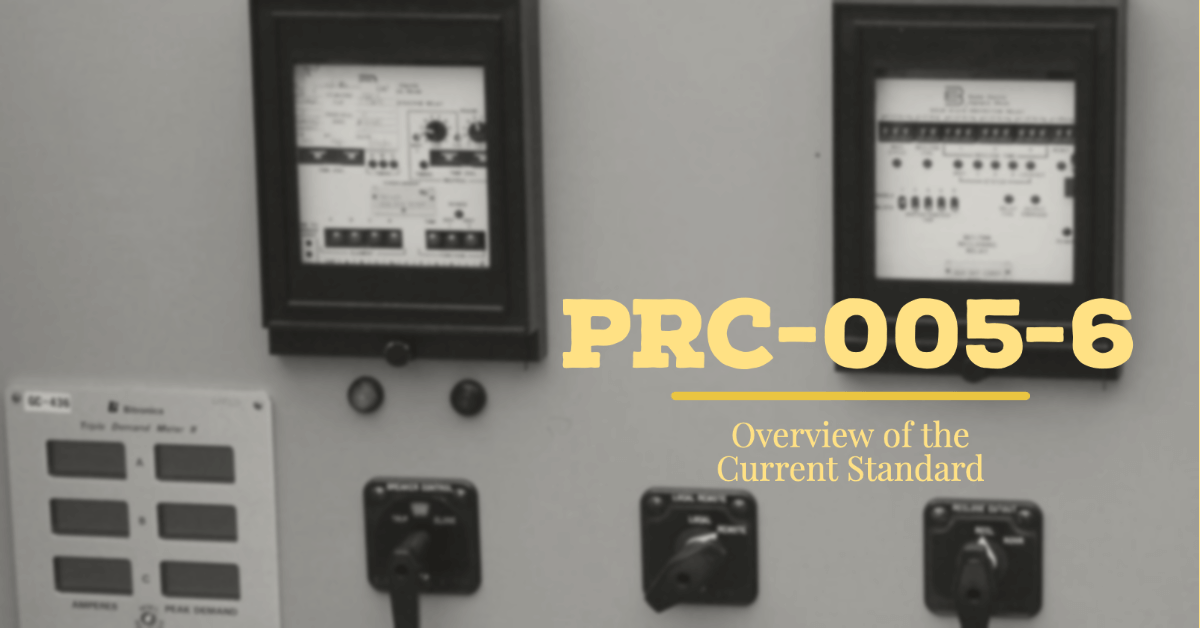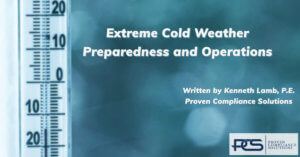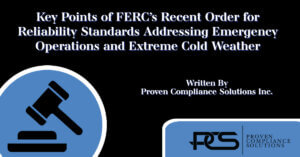NERC Reliability Standard PRC-005-6, Protection System, Automatic Reclosing, and Sudden Pressure Relaying Maintenance is almost always included in an audit, self-certification or other compliance monitoring activity. The NERC PRC-005-6 standards are designed to establish requirements for planning, designing, implementing, and maintaining protection and systems control within the power industry. Compliance with the standards is mandatory for entities operating in the North American bulk power system.
Below is a short overview of PRC-005-6 provided for Transmission Owners (TO), Generator Owners (GO), and Distribution Providers (DP), including its definitions and requirements.
On January 1, 2016, the current revision of PRC-005-6 became mandatory and enforceable. The revision captured months of significant efforts and numerous concurrently executed standard development projects under one revision. The transition also moved the development of maintenance and testing processes from an asset owner-defined, legacy program based on NERC Reliability Standards PRC‐005‐1.1b, PRC‐008‐0, PRC‐011‐0, and PRC‐017‐0, to an industry-accepted program built on a minimum set of repeatable maintenance activities implemented over a maximum maintenance interval. The Standard also established a minimum set of maintenance activities for automatic reclosing and sudden pressure relaying component types and the maximum allowable maintenance intervals for those activities. TOs, GOs, and DPs have been expected to transition their programs to one of the maintenance methods identified in the current NERC Reliability Standard PRC-005-6, but only after these entities had performed the minimum set of identifiable maintenance activities under the new program. Until then, entities were expected to transition the maintenance and testing of their Protection Systems over a phased-in testing implementation schedule defined by the Reliability Standard’s Implementation Plan. For a maximum allowable interval of six calendar years or twelve calendar years, this would be before April 1, 2021, and April 1, 2027, respectively. For any new components installed after April 1, 2015, the maximum allowable maintenance intervals of those components was to be maintained in accordance with the industry-accepted program.
Key Definitions from the NERC Glossary for PRC-005-6 Compliance
The following definitions are referenced within NERC Reliability Standard PRC-005-6:
- Protection System comprises of 1) protective relays that respond to electrical quantities, 2) communications systems necessary for the correct operation of a protective function, 3) voltage and current sensing devices providing inputs to a protective relay, 4) station DC power supply associated with a protective function, including station batteries, battery chargers, and non-battery-based DC power supplies, and 5) control circuitry associated with a protective function through the trip coil(s) of the circuit breakers or other interrupting devices.
- Protection System Maintenance Program is an ongoing program by which Protection System, Automatic Reclosing, and Sudden Pressure Relaying Components are kept in working order and proper operation of malfunctioning Components is restored. The maintenance program for a specific Component will include one or more of the following activities: 1) verification to ensure the Component is functioning correctly, 2) monitoring to observe the routine in-service operation of the Component, 3) testing by applying signals to a Component for troubleshooting or observing its functional performance or output behavior, 4) inspection to examine for signs of Component failure, reduced performance, or degradation, and 5) calibration to adjust the operating threshold or measurement accuracy of a measuring element to meet the intended performance requirement.
Definitions Used in this Standard
The following definitions are used within the NERC Reliability Standard PRC-005-6:
- Automatic Reclosing: Includes 1) reclosing relay, 2) supervisory relay(s) or function(s) that perform voltage and/or sync check functions that enable or disable operations of the reclosing relay, 3) voltage sensing devices associated with the supervisory relay(s) or function(s), and 4) control circuitry associated with the reclosing relay or supervisory relay(s) or function(s).
- Component: Any individual, discrete piece of equipment included within in a Protection System, Automatic Reclosing, or Sudden Pressure Relaying device.
- Component Type : Defined as any one of the five specific elements of a Protection System, any one of the four specific elements of an Automatic Reclosing device, or any one of the two specific elements of Sudden Pressure Relaying device.
- Countable Event: A failure of a Component requiring repair or replacement, any condition discovered while implementing the maintenance activities listed within the Maintenance Tables listed within NERC Reliability Standard PRC-005-6 that requires corrective action, or a Protection System Misoperation attributed to hardware failure or calibration failure. Note, a Misoperation caused by product design errors, software errors, relay settings different from specified settings, or a Component configuration or application errors are not considered a Countable Event. This definition is used exclusively for performance-based maintenance methods.
- Segment: Components of a consistent design standard, or a particular model or type from a single manufacturer that typically share other common elements. Consistent performance is expected across the entire population of a Segment, and the entire population must contain no less than 60 individual Components. This definition is used exclusively for performance-based maintenance methods.
- Sudden Pressure Relaying: A system that trips an interrupting device(s) to isolate the equipment it is monitoring and includes 1) a fault pressure relay, either a mechanical relay or device, that detects a rapid change in gas pressure, oil pressure, or oil flow that are indicative of a fault within liquid-filled, wire-wound equipment and 2) control circuitry associated with the fault pressure relay.
- Unresolved Maintenance Issue: A deficiency identified during a maintenance activity that causes the Component to not meet the intended performance, cannot be corrected during the maintenance interval, and requires follow-up corrective action.
Applicable Facilities
The following facilities apply to NERC Reliability Standard PRC-005-6:
- Protection Systems and Sudden Pressure Relaying devices that are installed for the purpose of detecting Faults on BES Elements, such as lines, bus infrastructure, or transformers.
- Protection Systems used for Underfrequency Load-Shedding (UFLS) systems installed per NERC UFLS Reliability Requirements.
- Protection Systems used for Undervoltage Load-Shedding (UVLS) systems installed to prevent system voltage collapse or voltage instability for BES reliability.
- Protection Systems installed as a Remedial Action Scheme (RAS) for BES reliability, as well as any Automatic Reclosing devices identified as an integral part of the RAS.
- Protection Systems and Sudden Pressure Relaying devices for BES generator Facilities, except for those facilities identified through Inclusion I4 of the BES definition, that include:
- Protection Systems that act to trip the generator either directly or via lockout or auxiliary tripping relays.
- Protection Systems and Sudden Pressure Relaying devices for generator step-up (GSU) transformers for generators that are part of the BES.
- Protection Systems and Sudden Pressure Relaying devices for station service or excitation transformers connected to the generator bus of generators that are part of the BES and act to trip the generator either directly or via lockout or tripping auxiliary relays.
- Protection Systems and Sudden Pressure Relaying devices for BES generator Facilities that are identified through Inclusion I4 of the BES definition (i.e. for dispersed power producing resources) and that aggregate to greater than 75 MVA to a common point of connection at 100kV or above.
- Automatic Reclosing devices applied on the terminals of BES Elements connected to the bus of a generating plant substation, or a second substation one bus away and less than 10 circuit-miles from the first substation, where the total installed gross generating plant capacity is greater than the gross capacity of the largest BES generating unit identified within the asset owner’s Balancing Authority (BA) Area or its BA’s Reserve Sharing Group. Note, these devices will not apply if the asset owner can demonstrate that a close-in three-phase fault present for twice the normal clearing time does not result in a total loss of gross generation in the Interconnection and exceeds the gross capacity of the largest relevant BES generating unit where the devices are applied.
Requirements
- Requirement R1 requires each applicable entity to establish a Protection System Maintenance Program for its applicable Components, including the identification of the maintenance method used for each Component and the list of Component attributes where monitoring is used to extend the maintenance intervals of those Components. All batteries associated with the station DC power supply Component Type of a Protection System must be included in a time-based maintenance program.
- Requirement R2 requires each applicable entity using a performance-based maintenance method to follow the Attachment A procedures embedded within the NERC Reliability Standard to establish and maintain its performance-based maintenance intervals.
- Requirement R3 requires each applicable entity to use its time-based maintenance program to maintain its Components using a minimum set of maintenance activities that are implemented within a maximum maintenance intervals, as prescribed within the Maintenance Tables of the NERC Reliability Standard.
- Requirement R4 requires each applicable entity using a performance-based maintenance method to implement its Component maintenance program, as established in Requirement R2.
- Requirement R5 requires each applicable entity to demonstrate its efforts to correct any identified Unresolved Maintenance Issues that occurred.
Implementation Guidance
To assist applicable entities, NERC has endorsed an Implementation Guidance that was developed by several entity stakeholders operating within the MRO Region. The document provides examples, recommendations, and presentations on how to identify applicable facilities and implement a Protection System Maintenance Program (PSMP) to meet the Requirements of NERC Reliability Standard PRC-005-6. Moreover, the NERC reliable standards aim to uphold various criteria such as testing protocols. Maintenance procedure and equipment standards.
Version seven is currently under development as Project 2019-04. Stay informed on these upcoming changes, as well all NERC Projects and Standards under development with our Standards Compliance Intelligence Portal, SCIP. For more information on how we can assist your organization with its NERC Reliability Standards compliance needs, contact Dale Zahn at (509) 504-5496. To learn more about Proven Compliance Solutions Inc., visit our website at www.provencompliance.com.
Common Questions About NERC PRC-005-6 Compliance
1. What is the purpose of NERC PRC-005-6? NERC PRC-005-6 ensures that Protection Systems, Automatic Reclosing, and Sudden Pressure Relaying Components are maintained to support the reliability of the bulk power system. It defines clear maintenance intervals and methods for compliance. |
2. Who must comply with PRC-005-6? Entities such as Transmission Owners (TOs), Generator Owners (GOs), and Distribution Providers (DPs) operating within the North American bulk electric system must comply with PRC-005-6. |
3. What components are covered under PRC-005-6? PRC-005-6 applies to Protection Systems, Automatic Reclosing devices, and Sudden Pressure Relaying systems that detect faults and help maintain BES reliability. This includes relays, control circuitry, batteries, and sensing devices. |
4. What are the maintenance methods defined in PRC-005-6? There are two methods: time-based and performance-based. Time-based involves scheduled maintenance within defined intervals, while performance-based uses data-driven analysis to extend those intervals under specific conditions. |
6. Is there an implementation deadline for maintenance intervals? Yes. For components installed before April 1, 2015, entities had until April 1, 2021 (six years) or April 1, 2027 (twelve years) to align with the new program. New components must follow the maintenance intervals immediately upon installation. |






